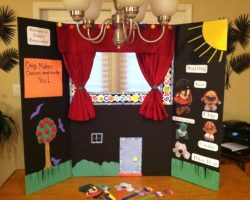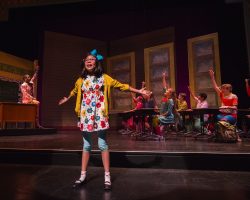Building Theaters at Home
Whether it’s a tiny table-top sized puppet theater or a full kid-sized mock-up, it’s easier than you think to bring home the fun of a full-fledged “theater.”
A real theater is not necessary, but part of the fun of putting on a show can be all the fuss and fanciness of a real theater – the curtains, the lights, the costumes, the sound effects. Sure, some real New York actor started an actual theater in his as-is living room (so can you), but a little embellishment adds to the sense of dramatic occasion!
Makes a great family project too.
This Lens will talk about creating (or buying, that works) and using theaters in your home with your children.
(The photo is from Benjamin Pollok’s Toy Shop.)
A Full Kid-Size Theater
Easier than you think!
Romeo and Juliet and Balcony LEVELS – Often there is a feature in your house that just screams “Show Biz!” Maybe a step or two – a change in level – between, say, the entry and the living room. Set dining room chairs in a row facing this and the higher lever is now “on-stage.” If your stairs are nearby that’s a bonus – now there are multi-levels for more dramatic blocking and Juliet can stand up a couple steps for her balcony (a tall stool twined with roses works well too).
DOORWAYS & CURTAINS – If there’s a wide doorway or opening between two spaces, add a curtain and that opening – Voila! – becomes a proscenium stage. This could be done as simply as by installing strong hooks at the upper corners of the opening, then tying a nylon cord clothes-line-style between them. A couple bedsheets (with the cord pulled through the biggest hem) become a pair of Grand Drapes. If you sew, then hemming lengths of a light-weight velour (red!) would make even more satisfying theater curtains. If feeling lavish, you could add fringe at the bottom. A more permanent version of this idea would be to install a drapery rod and velvet drapes. If your house is old enough or your decor traditional, these may be decorative: portieres were once very popular, partly because they look nice, partly because they stop drafts. (In “Gone With the Wind,” Scarlet wears her mother’s green velvet portieres as a dress.)
BED CURTAINS – This idea works well at a child’s bed, where a footboard and draperies make an easy puppet theater. (I knew one much-loved puppet theater that was the foot of a lower bunk plus gingham curtains – perfect.) In the book “Little Women,” Jo and her sisters performed their plays using the curtains of an old four-poster bed.
Curtains are always popular with junior thespians. If you have drapes covering a big patio door, have the actors do their acting on the patio, while the audience sits inside looking out. Or vice versa depending on whether the play is set in an interior or exterior. Do both! Make the audience move as real theaters do when performing “House and Garden.”
SCREENS – A pair of folding screens could make sides for a theater (mini-wings). You could paint these with theatrical motifs like Comedy and Tragedy masks. Would the kid version could be Smiley and Frowny Faces?
Do a little research on grand historic theaters to get ideas. (Researching with the kids might be a good lesson in history, architecture, and in library/research skills too. Then you get the messy fun of painting!) If very ambitious and with older children or teens, you could together design and build these “wing” screens. It would be easy with thin plywood and a scroll saw to give the wing-screens either the architectural profile of an old theater – then paint on the architecture – or to cut tree shapes for a more pastoral look.
Most ambitiously, perhaps for Scouts of a church youth group, you could create a whole demountable mini proscenium built from traditional theater flats of fabric stretched on 1×4 wood frames and painted.
Impromptu Theater!
Wonderful Cardboard! (from photos-public-domain.com) After all this planning for a theater at home, don’t forget how much fun – how creative – a spur-of-the-moment activity can be.
If your family gets a nice new appliance, throw away the new refrigerator or dishwasher and play with the box1 Cut out holes in it for a puppet theater and use socks straight out of the drawer with eyes etc. quickly pinned or sewn on. Or turn that box into the gingerbread house for a retelling of Hanzel and Gretel. I bet you could draw or paint on all the “candy” needed for that… or paint pop bottle caps and glue those on as “candies” or… Your imaginations are the only limits!
Midsummer’s Night’s Dream
Books on Theater for Kids
Here’s some material to use on-stage. Theater is all about story telling!
This is a great time to encourage your kid to make up stories, to take old stories like fairy tales and retell them as little stage dramas, to go looking (and reading) for new stories to tell.
Theater Buildings
A cultural history lesson (disguised as fun)
Shakespeare’s Globe Theater Researching theater buildings could be both fun and, well, educational. It will help in designing and decorating your at-home theater. Look at books and the internet for historic theaters like Shakespeare’s Globe Theater.
The Globe is particularly worth discussing. There’s the Shakespeare connection, of course. Even quite young children enjoy the story of “A Midsummer’s Night’s Dream” with it’s feuding fairies, it’s silly mortals running around, and the goofy guy with the donkey ears. Easy to slip in a history lesson here, filled with fascinating characters like Queen Elizabeth I and events like the discovery of America. (Try acting out the wreck of the Spanish Armada at bath time. Sink some duckies!)
The Globe Theater is also interesting as a building, with its construction of timbers infilled with brick and mud and its straw roof. A cannon shot during Shakespeare’s “Henry VIII” set fire to the thatch roof – another fun fact! (Perfect opportunity for Mom to perform the ever popular no-playing-with-matches speech.) This historic theater has been recently rebuilt – a interesting example of archeology and a potential field trip.
Visiting a local theater, especially if you’re lucky enough to have a good children’s theater and/or a historic theater in your area, would make a great (slightly less expensive) field trip. When you go, have a contest to see who can spot the most how-theater-works items off of the stage: notice the lobby; the box office and ticket collector; the program and what’s in it; the way seats, aisles, and balconies are designed; the many fire exits (fire has always been a problem in theaters even without cannons); the way the curtains, if any, work; the sets and lighting; the costumes. And the performances and story.
Or research the great opera houses of Paris and Milan. (More great field trips!) Talk about the Paris Opera House and the story of the Phantom. Play music from the musical. (There really IS a subterranean lake under the Opera. Really, truly.)
Assemble a Prop Box
Prop Box You can’t play theater without props and costumes!
First find a big box – or maybe two marked “Props” and “Costumes” in florid lettering.
Now fill the “Costume” box with Mom’s old shoes and party dresses for princess-wear and Dad’s ties or lumberjack flannel shirts. Add hats, red hoods and hero capes, shopkeepers’ aprons, fishermen’s hats, striped witchy socks, and anything else interesting that you can scrounge (scrounging is half the fun).
Then fill the “Prop” box with plastic swords and goblets and crowns, astronaut helmets (is that costume?), wood-choppers’ rubber axes and light sabers, baby bottles, toy animals, three bear-sizes of bowls with plastic porridge and other fake food including a poisoned plastic apple… plus all the other intriguing clutter that kids need to swash and buckle with.
Creating these theatrical trunks could be a lot of fun – and using them even more so!
(Remember in the book Little Women the contents of those sisters’ theater trunk? Most treasured was a pair of tall leather boots for the heroes to wear. For my kid, it was a pair of my boots from college – tall red leather with miles of laces – that became beloved pirate wear.)
Historic (and violent!) Puppetry
Puppets of Palermo (You might want to look this over before your kids do.)
This puppetry troupe from Palermo, or one very like it, visited Dallas years ago. My kid and I saw a performance. This is AUTHENTIC Medieval-style puppetry – which means Monty Pythonesque whacking with wooden swords and carved wooden limbs getting hacked off. My kid loved it! But I definitely saw some moms covering their younger children’s eyes.
The following website has a video clip (full of funny puppet beheadings etc.), interesting photos of puppets and workshops, and a link to Palermo’s marionette museum.



